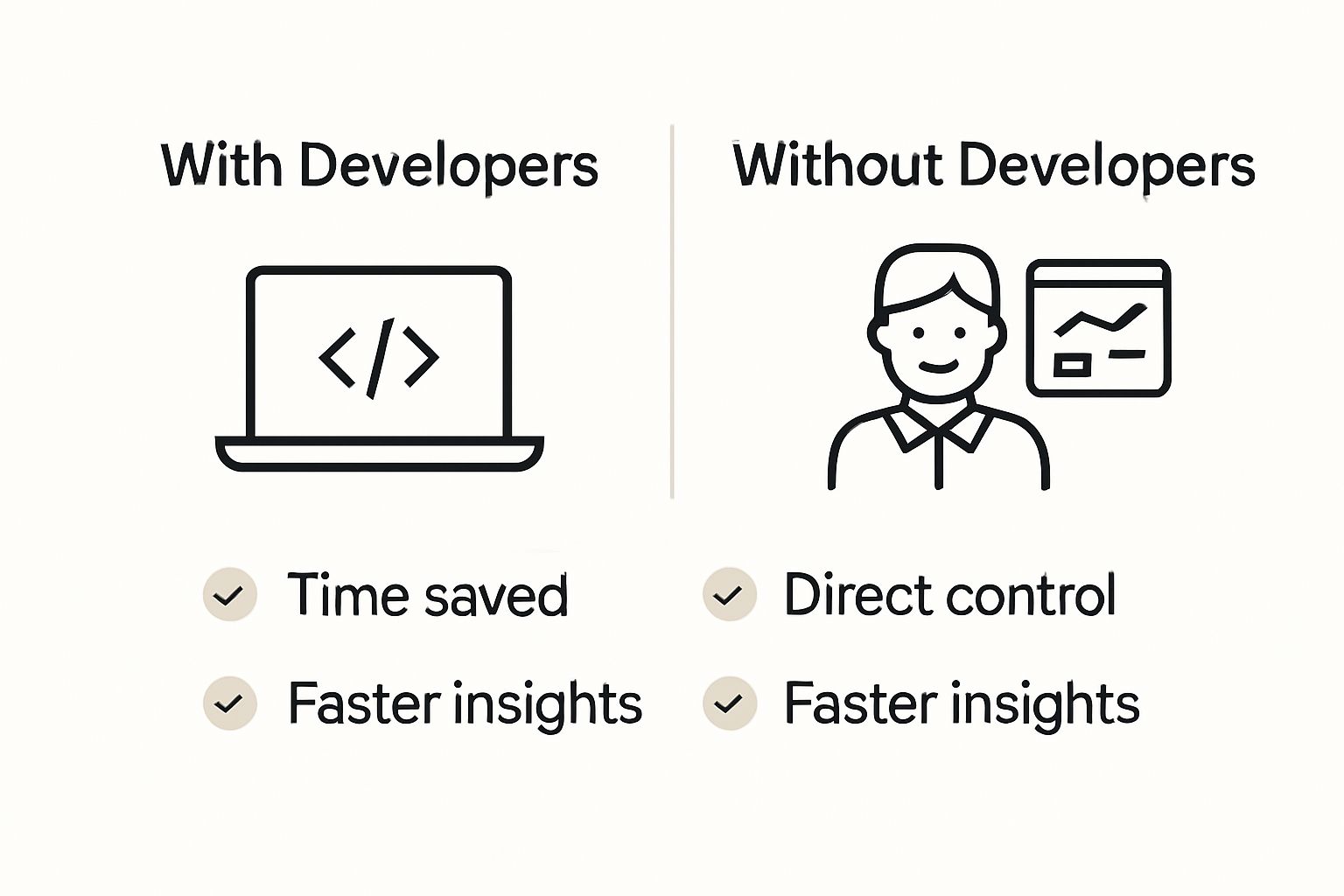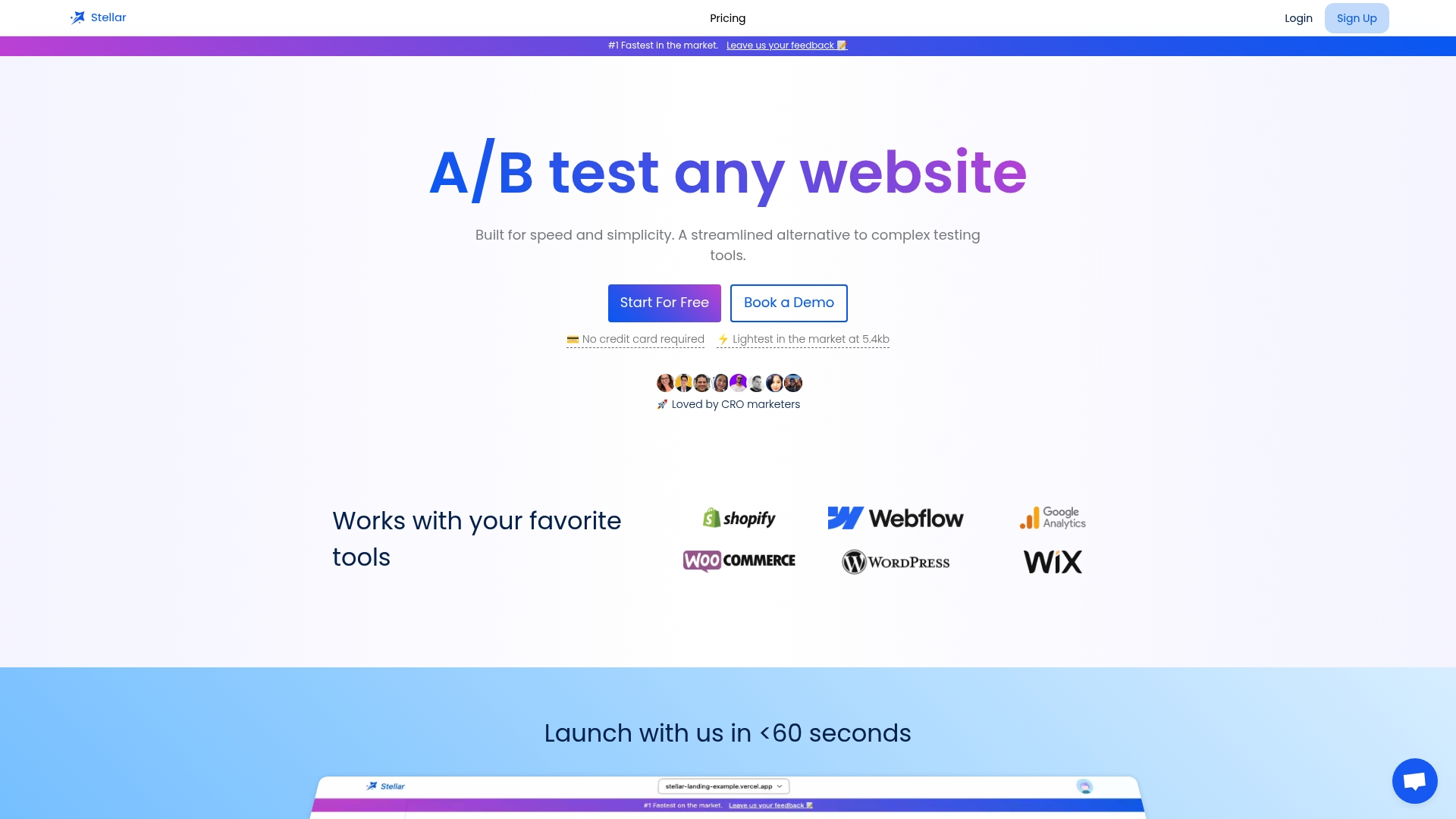
Understanding Running Tests Without Developers: A Deep Dive

Running tests used to be something only developers could handle or even understand. Now non-technical teams are taking the reins with tools that let them set up experiments and track results without ever touching a line of code. The wild part is how fast this shift is happening. Companies using robust testing frameworks have seen up to 35 percent better marketing effectiveness than those sticking to old ways. So why are the biggest winners not always the ones with the most developers on staff? The answer might surprise you.
Table of Contents
- What Does Running Tests Without Developers Mean?
- The Importance of Testing in Marketing Strategies
- Key Principles of Non-Developer Testing Approaches
- Tools and Technologies for Running Tests Independently
- Real-World Examples of Successful Non-Developer Testing
Quick Summary
| Takeaway | Explanation |
|---|---|
| Empower teams with no-code testing | Non-technical members can design and execute tests independently, enhancing agility and insight generation. |
| Rapid hypothesis validation possible | Teams can quickly iterate on experiments without waiting for developer support, driving faster decision-making. |
| Focus on data-driven marketing strategies | Embracing testing minimizes guesswork, allowing for strategic adjustments based on empirical evidence. |
| Accessible testing tools are essential | Modern platforms provide user-friendly interfaces that eliminate the need for complex technical skills. |
| Real-world examples demonstrate effectiveness | Successful case studies showcase how organizations optimize performance without extensive technical resources. |
What Does Running Tests Without Developers Mean?
Running tests without developers represents a transformative approach in digital experimentation where non-technical team members independently design, execute, and analyze tests without requiring direct engineering intervention. This methodology empowers marketing, product, and growth teams to take control of their experimental processes, reducing dependency on technical resources and accelerating insight generation.
The Core Concept of Independent Testing
At its essence, running tests without developers means utilizing no-code or low-code platforms that enable team members with minimal technical expertise to conduct sophisticated experiments. According to research from usability testing experts, this approach democratizes testing by providing intuitive interfaces that abstract complex technical requirements.
Key characteristics of independent testing include:

- Accessible user interfaces that require minimal technical training
- Visual editors for designing experiments
- Real-time analytics and reporting capabilities
- Automated statistical significance calculations
Why Non-Technical Teams Need Independent Testing
Marketers, product managers, and growth specialists often face significant bottlenecks when relying exclusively on developer resources for experimentation. Running tests without developers addresses these challenges by providing direct control and rapid iteration capabilities. Learn more about A/B testing without dev support to understand how modern tools are revolutionizing experimental workflows.
Independent testing platforms eliminate traditional barriers by offering user-friendly interfaces that translate complex testing protocols into simple, actionable workflows. This approach allows teams to quickly validate hypotheses, optimize user experiences, and make data-driven decisions without waiting for technical implementation or intervention.
The Importance of Testing in Marketing Strategies
Testing has transformed from a peripheral activity to a critical cornerstone of modern marketing strategies, enabling businesses to make data-driven decisions that directly impact growth and performance. By systematically evaluating different approaches, marketing teams can uncover insights that drive more effective customer engagement and conversion optimization.
Understanding Strategic Marketing Testing
Strategic marketing testing involves methodically experimenting with various elements of marketing campaigns to understand what resonates most with target audiences. Research from Harvard Business Review indicates that companies implementing robust testing frameworks can improve marketing effectiveness by up to 35% compared to traditional approaches.
Key strategic testing domains include:
- Website user experience design
- Email marketing campaign structures
- Landing page conversion elements
- Digital advertising messaging and visuals
- Pricing strategy variations
Why Data-Driven Experimentation Matters
Marketing teams that embrace testing move beyond guesswork and intuition, replacing subjective decision-making with empirical evidence. Discover advanced A/B testing strategies for digital marketing to understand how systematic experimentation can transform marketing performance.
The core value of strategic testing lies in its ability to minimize risk and maximize marketing investment. By continuously learning from real-world customer interactions, businesses can refine their approaches, reduce wasted resources, and create more targeted, resonant marketing experiences that directly contribute to organizational growth and customer satisfaction.

Key Principles of Non-Developer Testing Approaches
Non-developer testing approaches represent a paradigm shift in digital experimentation, focusing on creating accessible, intuitive methodologies that empower team members across different skill levels to conduct sophisticated tests without deep technical expertise.
Foundational Principles of Accessible Testing
According to user experience research, successful non-developer testing hinges on several critical principles that democratize the experimental process. These principles transform complex technical requirements into user-friendly workflows that anyone can navigate.
Core principles include:
- Intuitive visual interfaces that abstract technical complexity
- Drag-and-drop experiment design capabilities
- Real-time data visualization and interpretation
- Automated statistical analysis and significance calculations
- Zero-coding requirement for experiment implementation
Empowering Non-Technical Teams Through Advanced Tools
Modern testing platforms have evolved to provide comprehensive solutions that bridge the gap between technical complexity and user accessibility. Explore fast website testing strategies to understand how cutting-edge tools are revolutionizing experimental approaches.
The key objective of non-developer testing is to remove technical barriers, allowing marketing, product, and growth professionals to rapidly design, execute, and analyze experiments. By providing intuitive interfaces and automated backend processes, these approaches enable teams to make data-driven decisions quickly and efficiently, without requiring extensive programming knowledge or developer intervention.
The table below compares the roles and benefits of traditional developer-driven testing versus non-developer (independent) testing as outlined in the article.
| Aspect | Developer-Driven Testing | Non-Developer (Independent) Testing |
|---|---|---|
| Who runs experiments | Developers or engineers | Non-technical teams (marketing, product, etc.) |
| Speed of iteration | Slower, dependent on developer resources | Faster, direct control by campaign owners |
| Technical barrier | Requires coding skills | No coding skills required |
| Resource dependency | High dependency on technical support | Low dependency, enabled by no-code tools |
| Impact on agility | Longer turnaround times for tests | Rapid hypothesis validation and action |
Tools and Technologies for Running Tests Independently
Independent testing technologies have revolutionized how non-technical teams approach digital experimentation, providing powerful platforms that eliminate traditional technical barriers and democratize data-driven decision-making processes.
Characteristics of Modern Independent Testing Technologies
According to Google's optimization research, contemporary testing tools share several critical technological characteristics that enable seamless, user-friendly experimentation. These technologies focus on creating accessible interfaces that transform complex testing requirements into intuitive workflows.
To clarify the essential features that distinguish modern independent testing technologies, the table below summarizes their core characteristics as described in this article.
| Feature | Description |
|---|---|
| Visual drag-and-drop experiment builder | Allows users to design experiments without coding by arranging elements visually |
| No-code configuration interface | Enables setup and management of tests through simple, code-free controls |
| Integrated statistical analysis engine | Automatically processes results to determine statistical significance |
| Real-time data visualization dashboard | Provides instant insights into test performance with live charts and graphs |
| Automatic variant management system | Manages and tracks multiple test variations effortlessly |
Essential technological features include:
- Visual drag-and-drop experiment builders
- No-code configuration interfaces
- Integrated statistical analysis engines
- Real-time data visualization dashboards
- Automatic variant management systems
Evaluating Independent Testing Platforms
Selecting the right independent testing technology requires understanding specific organizational needs and platform capabilities. Explore speed-focused A/B testing tools for 2025 to gain insights into cutting-edge testing technologies that prioritize performance and usability.
The most effective independent testing platforms seamlessly combine powerful backend computational capabilities with user-friendly frontend experiences. By abstracting technical complexities, these technologies enable marketing, product, and growth teams to design, execute, and analyze sophisticated experiments without requiring advanced programming skills or continuous developer support.
Real-World Examples of Successful Non-Developer Testing
Successful non-developer testing demonstrates how organizations across various industries leverage accessible technologies to drive meaningful insights and optimize performance without requiring extensive technical resources or prolonged development cycles.
Enterprise Marketing Transformation
Research from healthcare technology studies highlights how organizations are using no-code testing platforms to rapidly experiment and iterate on complex business processes. Marketing teams have particularly benefited from these approaches, enabling rapid experimentation without traditional technical bottlenecks.
Notable real-world testing scenarios include:
- E-commerce conversion rate optimization
- Digital advertising messaging refinement
- Website user experience enhancement
- Customer journey personalization
- Landing page design validation
Impact Across Different Business Domains
Explore core web vitals testing strategies to understand how businesses are implementing sophisticated testing approaches without heavy technical investments.
The most compelling non-developer testing examples demonstrate how marketing, product, and growth teams can independently design sophisticated experiments. By utilizing intuitive platforms with powerful backend capabilities, organizations can quickly validate hypotheses, reduce implementation costs, and accelerate data-driven decision-making processes across multiple business domains.
Unlock Rapid Testing Freedom With Stellar
Struggling to run tests without developers has probably slowed your marketing, drained resources, and left your ideas waiting for technical support. The pain of dependency is real—complicated processes and traditional barriers keep teams from fast insights and winning experiments. If you crave total control and actionable results, it is time to discover how simple independent testing can be.

Imagine launching impactful A/B tests in minutes with no code, no bottlenecks, just results. Stellar streamlines your experiments with a truly lightweight A/B testing script, built-in visual editor, and real-time analytics that anyone can master. Marketing teams and growth leaders use our no-code A/B testing solution to eliminate delays and capture proven improvements. Take control of your experiments today. Explore how Stellar puts powerful independent testing into your hands now—sign up and start optimizing without any technical hurdles.
Frequently Asked Questions
What does it mean to run tests without developers?
Running tests without developers refers to a process where non-technical team members independently design, execute, and analyze experiments using no-code or low-code platforms, reducing the need for technical resources.
How can marketing teams benefit from independent testing?
Marketing teams can benefit from independent testing by gaining direct control over their experiments, allowing for rapid iterations and data-driven decision-making without relying on developer support, thus optimizing user experiences more quickly.
What features should I look for in independent testing tools?
Look for features like intuitive visual interfaces, drag-and-drop experiment builders, no-code configuration, integrated statistical analysis, and real-time data dashboards to facilitate easy experimentation.
How does strategic marketing testing improve campaign effectiveness?
Strategic marketing testing improves campaign effectiveness by enabling systematic evaluations of different marketing elements, leading to insights that enhance customer engagement and optimize conversion rates.
Recommended
- Core Web Vitals Ab Testing: How to Test Without the Bloat
- Performance-First Split Testing: Why Every Millisecond Matters
- Fast Testing, Fast Results: Speed-Focused A/B Tools for 2025
- 5 Lightweight A/B Testing Platforms That Won't Slow Your Site
- Understanding PHP Testing: Importance and Mechanisms - jakovic.com
- blog | siift | Founder Problems
Published: 10/10/2025